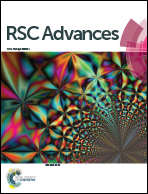Non-invasive detection and chemical mapping of trace metal residues on the skin†
Abstract
Residual traces of the metals copper and lead on an individual's skin may be elucidated by reaction of rubeanic acid with a gelatine lift taken from the target area in question, yielding intensely coloured reaction products. This non-invasive technique has been shown to offer promise in chemically mapping the distribution of the minute metal residues across an individual's hand deposited through touching metal items, a technique with potential forensic significance.


 Please wait while we load your content...
Please wait while we load your content...